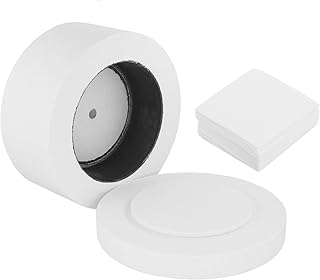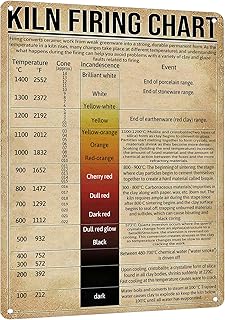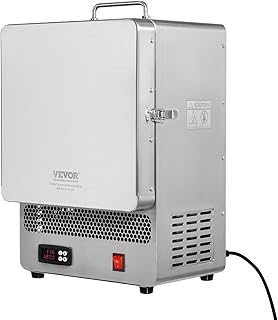
The Ultimate Guide to Choosing a Pottery Kiln for Your Home (Avoid Mistake #4!)
Choosing the right pottery kiln can be overwhelming, but it doesn’t have to be! In this guide, we’ll walk you through essential tips and common pitfalls to avoid—like the costly mistake of overlooking your space needs. Let’s ensure your creative journey starts on the right foot with the perfect kiln!
Are you ready to dive into the world of pottery? Maybe you’ve been inspired by the beauty of handcrafted ceramics or the calming process of molding clay. Whatever your motivation, choosing the right pottery kiln for your home can make all the difference in your creative journey. I created this guide to help you navigate the often-overwhelming options available. Let’s simplify things together.
This post is designed for anyone eager to start pottery at home, whether you’re a complete beginner or someone looking to upgrade your setup. If you’re excited about creating unique pieces but feel daunted by the variety of pottery kilns out there, you’re in the right place. You likely care about making the best choice without wasting money or time, and I get that.
In this ultimate guide, you’ll find practical tips to help you choose the best kiln for your needs. From understanding your unique requirements to budgeting wisely, I’ll cover everything you need to know. Plus, I’ll highlight common mistakes to avoid, including the crucial Mistake #4 that could impact your pottery experience. By the end, you’ll feel confident in your decision, ready to create beautiful works of art right from the comfort of your home.
Let’s get started on this exciting journey into the world of pottery kilns!
Key Takeaways
– Understand your needs by outlining what types of projects you want to pursue before selecting a kiln.
– Choose the right size based on the space you have available and the volume of work you plan to produce.
– Compare different kiln types, such as electric, gas, and wood-fired, to find the one that suits your style.
– Set a realistic budget that includes both the kiln and additional costs like installation and accessories.
– Don’t overlook safety features; ensure your kiln has adequate protections for safe home use.
1. Understand Your Needs
Before you start looking for a pottery kiln, take a moment to think about what you truly need. Are you planning to work with earthenware, stoneware, or porcelain? Each type of clay requires a different firing temperature, so your kiln must reach those specific levels. Also, think about how often you’ll use it and how many pieces you’ll create. Are you just a hobbyist or aiming to go professional?
Here are some important points to consider:
– Type of Clay: Each clay type needs a different firing temperature.
– Frequency of Use: If you plan to use it a lot, invest in a strong model.
– Space: Ensure your kiln fits comfortably in your workspace.
By understanding your needs, you can avoid spending money on a kiln that won’t work for you.
Understand Your Needs
Editor’s Choice
PYY Electric Kiln – 1500W Melter Furnace Oven Pottery Kilns, Hi-Temp 220…
Fixwal 15.8in Floating Shelves, Set of 6 Wood Shelves, Farmhouse Shelf W…
2. Choose the Right Size
The size of your pottery kiln really matters! Think about how many pieces you usually make at the same time. If you create larger items, you will need a bigger kiln. Smaller kilns are great for beginners or for those with limited space, but think about the future. What if you want to create more?
Here are some size tips:
– Small Kilns: Ideal for small projects and easy to move.
– Medium Kilns: A good fit for most hobbyists.
– Large Kilns: Best for serious potters needing to produce multiple items.
Picking the right size now will save you trouble later.
Choose the Right Size
Editor’s Choice
Large Microwave Kiln for Glass Fusing Clay Pottery with 10 Sheets Kiln P…
PYY Electric Kiln – 1500W Melter Furnace Oven Pottery Kilns, Hi-Temp 220…
PYY Electric Kiln – 1500W Melter Furnace Oven Pottery Kilns, Hi-Temp 220…
3. Explore Different Kiln Types
Did you know there are different types of kilns? Each type has unique features. Electric kilns are perfect for beginners because they are easy to use. Gas kilns offer unique firing effects, while wood-firing and raku kilns are for those who love to experiment!
Here’s a simple breakdown:
– Electric Kilns: User-friendly and great for indoor use.
– Gas Kilns: Provide interesting effects but need proper ventilation.
– Wood-Fired Kilns: Perfect for traditionalists and outdoor setups.
Knowing the differences helps you choose the right kiln for your pottery style.
Explore Different Kiln Types
Editor’s Choice
PYY Electric Kiln – 1500W Melter Furnace Oven Pottery Kilns, Hi-Temp 220…
PYY Electric Kiln – 1500W Melter Furnace Oven Pottery Kilns, Hi-Temp 220…
Glazes – Raku Series – Dragon Fire – Low Fire Raku (16 fl oz | 473 ml)
4. Budget Wisely
Kilns can cost anywhere from a few hundred to thousands of dollars. While you may want to save money, remember that a quality kiln enhances your pottery experience. Consider not just the initial cost but also electricity, maintenance, and any extra equipment you might need.
Here are some budgeting tips:
– Set a Budget: Choose a realistic price range that fits your finances.
– Research: Look into different brands and read reviews for the best value.
– Consider Used Options: Sometimes second-hand kilns can be a great deal, just ensure they work well.
Budgeting wisely means you’ll find a kiln that fits your artistic needs and your wallet.
Fun fact: a quality pottery kiln can save you money in the long run; factor in electricity, maintenance, and future projects, not just the upfront price, when budgeting for pottery kilns. Budget wisely: set a realistic range, research brands, and consider used options for the best value.
Budget Wisely
Editor’s Choice
PYY Electric Kiln – 1500W Melter Furnace Oven Pottery Kilns, Hi-Temp 220…
5. Energy Source Matters
The energy source of your kiln affects how much it costs to run and what it can do. Electric kilns are great for convenience, while gas kilns can be cheaper in the long run with the right setup. Depending on where you live and energy prices, you might save money by picking the best energy source.
Consider these options:
– Electric: Easy for beginners; simply plug it in.
– Gas: Can be cost-effective but needs more setup.
– Wood: Offers unique results but requires more work.
Choosing the right energy source can save you money and improve your pottery outcomes.
Energy source matters: switching to the right setup can cut kiln running costs by up to 40%. Electric kilns are convenient for beginners, while gas kilns shine on long sessions when prices drop—so factor your energy prices into choosing pottery kilns.
Energy Source Matters
Editor’s Choice
PYY Electric Kiln – 1500W Melter Furnace Oven Pottery Kilns, Hi-Temp 220…
PYY Electric Kiln – 1500W Melter Furnace Oven Pottery Kilns, Hi-Temp 220…
HYBLOM Vintage Home Room Art Decor – Kiln Firing Chart Metal Sign, Potte…
6. Check the Safety Features
Safety is crucial when choosing a kiln. Look for features like automatic shut-off systems, good ventilation, and strong construction. These factors are especially important if you’ll use the kiln at home with family and pets nearby.
Keep these safety features in mind:
– Ventilation: Helps safely remove harmful gases.
– Insulation: Keeps heat in and protects users.
– Automatic Shut-off: Gives peace of mind during long firings.
Choosing a kiln with proper safety features lets you focus on your art without worry.
Check the Safety Features
Editor’s Choice
PYY Electric Kiln – 1500W Melter Furnace Oven Pottery Kilns, Hi-Temp 220…
Newtex Heat Resistant Mitts – High-Temperature Fiberglass Mitts Up to 20…
7. Compare Warranty Options
A good warranty can save you a lot of headaches later on. Since kilns are an investment, knowing you’re covered if something goes wrong is reassuring. Check the warranty terms to see what they cover. Some brands even offer service support, which is a great help for beginners.
Look for these warranty details:
– Coverage Duration: Longer warranties show manufacturer confidence.
– Parts vs. Labor: Know what the warranty includes.
– Customer Support: Check how easy it is to get help.
A solid warranty can be your safety net, allowing you to create without stress.
Compare Warranty Options
Editor’s Choice
VEVOR Electric Kiln, 1500W Melting Furnace Max Temperature 2192℉/1200℃, …
8. Read Customer Reviews
Nothing beats learning from actual users! Reading customer reviews gives you real feedback on how well a kiln performs. Look for common themes in reviews to gauge reliability and effectiveness. Users often share insights about ease of use and firing capabilities.
Pay attention to these points:
– Common Complaints: Knowing what issues might arise helps in decision-making.
– Positive Experiences: Look for reviews praising durability.
– User Photos: These show the kiln in action.
Taking time to read reviews can help you avoid mistakes.
Read Customer Reviews
Editor’s Choice
PYY Electric Kiln – 1500W Melter Furnace Oven Pottery Kilns, Hi-Temp 220…
Nuanchu 4 Pack Wide Kiln Post High Alumina Kiln Posts Square Ceramic She…
Pyrometer High Temp Thermometer Gun, AP-2732 Laser Thermometer Gun -58℉~…
9. Consider Portability
If you plan to move your kiln or use it in different places, portability is key. Some kilns are lightweight and easy to transport, while others are more stationary. Think about whether you need a kiln that fits in your car or one that stays in one spot.
Here are some tips for choosing a portable kiln:
– Weight: Lighter kilns are easier to move.
– Size: Smaller kilns are often more transportable.
– Setup Time: Look for kilns that are quick to set up.
Picking a portable kiln gives you more creative possibilities!
Consider Portability
Editor’s Choice
PYY Electric Kiln – 1500W Melter Furnace Oven Pottery Kilns, Hi-Temp 220…
CasterHQ 18″x30″ Heavy-Duty H-Frame Dolly – 1000 lbs Capacity – Made in …
10. Seek Community Advice
Joining a pottery community can give you valuable insights when picking your kiln. Forums, local classes, and social media groups are excellent for getting recommendations and sharing experiences. Fellow potters can offer tips you won’t find in manuals and help point you towards the best kiln for your needs.
Consider these resources:
– Local Pottery Classes: Connect with instructors and peers.
– Online Forums: Share information with potters everywhere.
– Social Media Groups: Stay updated on tips and trends.
Working with others enriches your pottery journey and helps you make wise choices.
When you’re choosing pottery kilns for your home, your best resource is the community—local classes, forums, and groups will save you days of guesswork. Tap into fellow potters for honest recommendations, tips, and real-world DIY proof before you buy.
Conclusion
Choosing the right pottery kiln for your home can seem daunting, but with these tips in hand, you’re well on your way to making an informed decision. Remember, your kiln is an investment in your creative journey, so take the time to understand your needs and options. Happy potting, and may your future creations be bright!
Don’t forget to reach out to fellow potters to share your journey and gather more advice!
Note: We aim to provide accurate product links, but some may occasionally expire or become unavailable. If this happens, please search directly on Amazon for the product or a suitable alternative.
This post contains Amazon affiliate links, meaning we may earn a small commission if you purchase through our links, at no extra cost to you.
Frequently Asked Questions
What Should I Consider When Choosing a Pottery Kiln for My Home?
Choosing the right pottery kiln for your home involves several important factors. First, think about the type of pottery you’ll be making. Different kilns cater to various clay types and firing temperatures. Also, consider the space you have available, as kilns can vary significantly in size. Don’t forget to look into power requirements as well, since some kilns need special electrical setups. Finally, budget is crucial; find a kiln that balances quality with your financial plan!
What Are the Different Types of Pottery Kilns Available for Home Use?
There are several types of pottery kilns available, each with its unique advantages. Electric kilns are popular for home use due to their ease of use and minimal setup requirements. Gas kilns offer more control over firing but may require more ventilation. If you’re into raku pottery, a raku kiln is essential for that specific technique. Lastly, consider portable kilns for smaller projects or limited spaces. Each option has its benefits, so choose based on your specific pottery goals!
How Can I Avoid Common Mistakes When Setting Up My Pottery Kiln at Home?
One common mistake many beginners make is not properly preparing the location for their pottery kiln. Ensure your kiln is set up in a well-ventilated area away from flammable materials. Additionally, always refer to the manufacturer’s guidelines for installation and operation. Avoid overcrowding your kiln when firing, as this can lead to uneven results. Lastly, familiarize yourself with proper kiln firing schedules to prevent mishaps. By being mindful of these details, you’ll set yourself up for success!
What Are the Costs Associated with Buying and Maintaining a Pottery Kiln?
The costs of purchasing a pottery kiln can vary widely based on the type and size. Entry-level electric kilns might start around $500, while larger, more advanced models can cost several thousand dollars. Don’t forget to budget for accessories like kiln shelves, posts, and safety gear. Maintenance costs can also add up, especially for gas kilns that may require more frequent servicing. Always factor in these ongoing costs when planning your pottery journey at home!
How Long Does It Typically Take to Fire Pottery in a Home Kiln?
The firing time in a pottery kiln can vary depending on several factors, including the type of kiln, the temperature being reached, and the size of the load. Generally, a bisque firing might take around 8 to 12 hours, while a glaze firing usually takes about 10 to 15 hours. However, these times can vary, so always consult your kiln’s manual for specific firing schedules. Patience is key, but the results will be worth the wait!
Related Topics
pottery kilns
home pottery
beginner pottery
kiln options
ceramic techniques
DIY pottery
pottery mistakes
artisanal pottery
home studio
advanced techniques
pottery tools
crafting at home
























Great tips! I’ve been thinking about getting a kiln for my home studio, but I definitely don’t want to mess it up. What features do you think are most important for a beginner like me?
I once tried to fire a piece in my old kiln and ended up with a mini volcano in my garage! Let’s just say my neighbors were surprised! 😂 Do you have any funny kiln stories?
Did you know that the oldest known kiln dates back to around 3000 BC? It’s amazing how long people have been working with clay! Makes me feel like I’m part of a very old tradition.